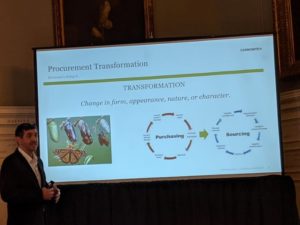Editor’s Note: Today concludes CPO Rising’s “best of” 2019 article series from last year, as we reflect on the year and prepare for the new year ahead. Stay tuned for fresh 2020 content next week!
 Last month at CPO Rising 2019, attendees had the pleasure of hearing from Bill Browning, Director of Procurement at Carbonite and a “friend of the firm,” who delivered a presentation entitled, “Empire State of Mind: Think Big, Start Small.” Bill has a 15-plus year track record of driving cost savings and efficiencies through effective sourcing, negotiation and vendor management strategies. At Carbonite, he currently oversees the management of over $120M across all indirect spend categories as he continues to design and build out the newly established Procurement function that now also includes the recently acquired Webroot.
Last month at CPO Rising 2019, attendees had the pleasure of hearing from Bill Browning, Director of Procurement at Carbonite and a “friend of the firm,” who delivered a presentation entitled, “Empire State of Mind: Think Big, Start Small.” Bill has a 15-plus year track record of driving cost savings and efficiencies through effective sourcing, negotiation and vendor management strategies. At Carbonite, he currently oversees the management of over $120M across all indirect spend categories as he continues to design and build out the newly established Procurement function that now also includes the recently acquired Webroot.
We were thus very happy to have Bill present on his experience with building a new procurement team from the ground up. He took us on his journey through the process, and offered us his lessons learned through it all. Bill began with what should happen on “Day 1” of this process, starting with an honest self-assessment that, to be frank, should never really end. He then talked about “minding the gap” between perceptions of what procurement does (“they’re only focused on price,” “they operate in a silo,” “they slow us down,” “they don’t know our business or our market,” “they make us bid on everything!“), versus what procurement should actually do. Bill then gave attendees some advice on how to change those perceptions to re-position procurement as a strategic value driver.
“It is incumbent upon the CPO to engage and educate, then collaborate and execute,” he said.
Bill and his nascent team then had to face their reality. At Carbonite, they had:
- No procurement tools at all
- A decentralized, local approach to sourcing and procurement
- No visibility into spend and, therefore, savings
Thus, Bill and his team found themselves having to transform the procurement organization from glorified purchasers to strategic business partners, with or without the requisite tools.

Based on his and his team’s experience, Bill then gave some advice on how to start the actual transformation process (assess, address, and execute). Bill advised to break the plan down into several manageable steps — addressing stakeholders, real opportunities, the process, capabilities, and constraints — while keeping the bigger picture in mind.
He advised us to not “boil the ocean,” which can be tempting for any leader who’s starting out on this journey. Instead, procurement leaders should focus on collaborating with stakeholders — from the CEO to the line-of-business — getting access to any and all pertinent data, and employing data analytics and management tools to wrangle and make sense of that data.
“These,” he said, “led to impactful results and a pathway for future investment.”
Bill then talked about transformation disruptors, such as lacking resources, technology solutions, having multiple stakeholders, mergers and acquisitions, executive turnover, reorganization, and economic factors. But perhaps the biggest challenge all procurement teams have is managing data. Common data challenges for him and his team were having no formal spend reporting, no procurement support tools (again), multiple data sources with different owners, the data lacking sufficient detail. Bill then talked about making a business case for data management and analysis tools, and reiterated the need to derive valuable insights from data.
Bill then gave us some initial results from his team’s growth and transformation initiative, which included generating savings of $1.1 million to data (11%), establishing a network of stakeholders (breaking down more internal walls and establishing a regularly collaborative cadence), and continuously driving savings and process efficiencies — something that never ends and truly should never end.
Bill then closed out by providing a list of lessons learned for the audience, which are:
- Understand that there’s immense value in data — you cannot chart a course if you do not know your current position, and you can cannot adjust what you cannot measure
- Value internal stakeholder relationships — break down silos, reach across the aisle, seek first to understand and then be understood
- Continuously nurture your relationships — “a greenfield must be watered.” Once you’ve established relationships, work to communicate and collaborate and keep them aligned to your team’s mission
- Building brand is key to long-term success — in order to be known as strategic value drivers, you have to establish your team as strategic value drivers, and show up every day to prove it
We are so grateful for Bill for sharing his and his team’s experiences, and we wish them the best as they continue to grow the procurement function at Carbonite.
RELATED ARTICLES
CPO Rising 2019 Speaker Profile – Bill Browning, Director of Procurement at Carbonite
Is Your Procurement Team Best-in-Class? Four Key Enablers for Success
How to Transform Procurement in Five Steps – Step Five: External Stakeholder Engagement
